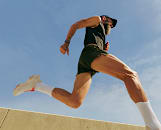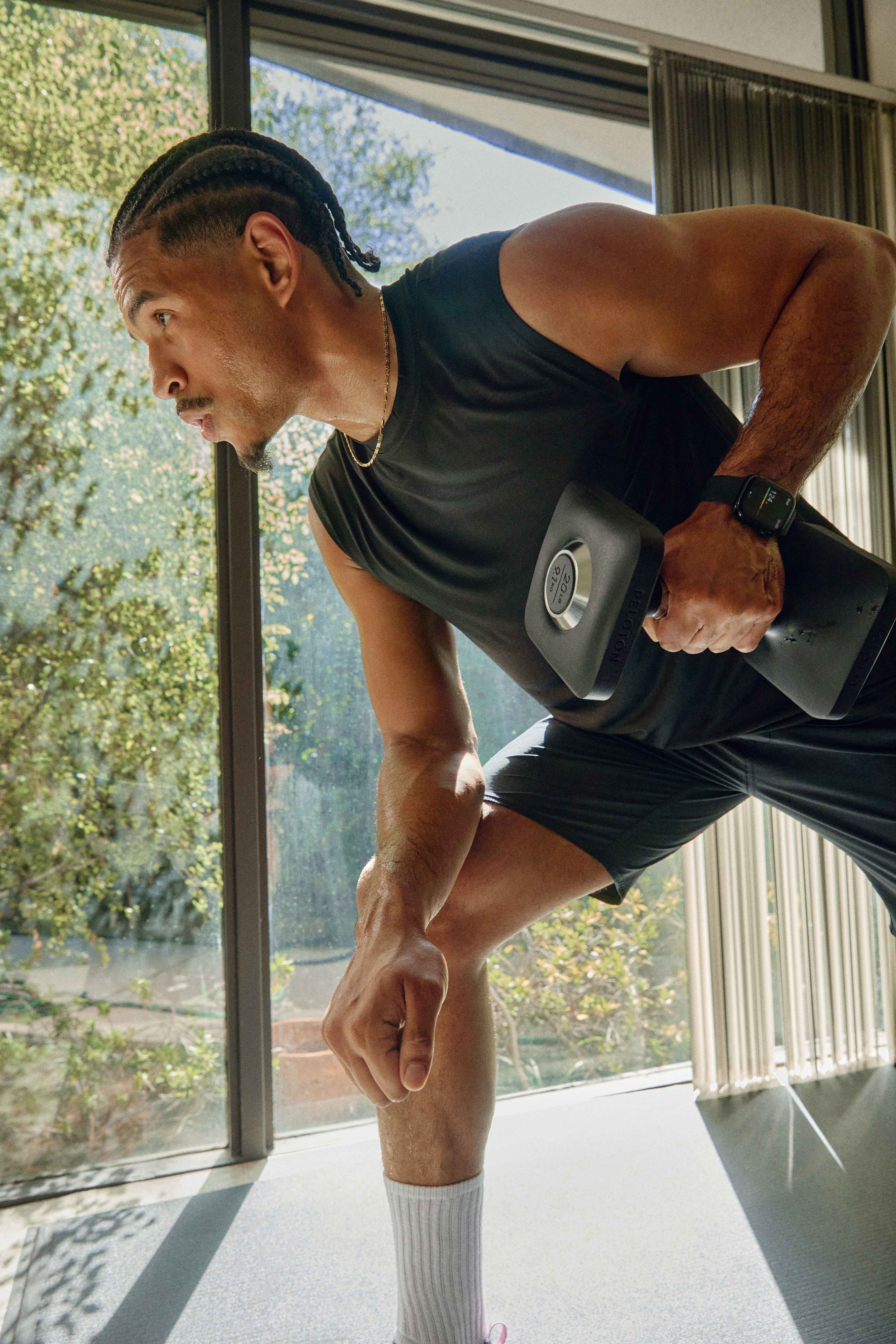
Strength Training Is Key to Living a Longer, Healthier Life. Here's How to Get Started
Strength training may be just what your fitness routine is missing.
By Julia Sullivan, Team Peloton•
What Is Strength Training?
Benefits of Strength Training
Types of Strength Training
Cardio vs. Strength Training
How to Start Strength Training
Sample Strength Training Exercises
Tips to Keep in Mind When Strength Training
Get Started Strength Training with Peloton
If you’ve ever been at the gym and wished you knew exactly what to do with those racks of free weights or how to manage a barbell, you’re not alone. Strength training can feel daunting for beginners, but it’s a workout modality just about anyone can—and should—engage in. Research shows that just 30 to 60 minutes of strength training per week can reduce a person’s risk of cancer and heart disease.
Discover more ways to reach your goals with Peloton
In this guide, you’ll discover how to build an effective strength training routine that works for you. You’ll also learn the plethora of benefits associated with resistance training and how it differs from cardiovascular exercise. You’ll also get to know functional strength training and walk through some foundational moves to try at home.
To help you get started on your strength training journey, we called on Peloton instructors Matty Maggiacomo and Cliff Dwenger to weigh in on some of the roadblocks you might encounter and provide encouragement along the way.
What Is Strength Training?
Strength training (also called resistance training) is a type of exercise that requires your muscles to contract against an opposing force, according to the National Institutes of Health (NIH). This opposing force can be gravity, the pull of a resistance band, the weight of a dumbbell, or even your own body weight.
When you engage in strength training, it triggers a cascade of positive adaptations throughout the body, including increasing muscle strength and size, boosting bone density, bolstering connective tissue, enhancing communication between your brain and muscles, improving your metabolic health, and shifting hormones—but more on all that, below.
What Is Functional Strength Training?
Functional strength training is a form of resistance training is made to mimic the physiological demands of real-life activities, with an emphasis on practical movements that help you move better throughout your day. The end goal of functional strength training is not just to grow stronger, but to improve on real-life movements, like lifting things, climbing stairs, and moving throughout everyday life. “When we train functionally, our body reacts more quickly and stays more stable in real-life situations,” Cliff says.
You can create resistance through the use of free weights, weighted fitness machines, bands, or bodyweight exercises to build strength and endurance. The goal is to increase your overall strength and muscle mass by taking a functional approach that will improve your mobility, safeguard against injury, and make moving through life easier. “One big benefit [of functional strength training] is improving intermuscular coordination, meaning your muscles learn to work together more efficiently to create movement,” Cliff explains. “It also helps prevent everyday injuries, like twisting an ankle or lifting something with poor posture.”

Peloton App
Access thousands of classes with no equipment needed.
Benefits of Strength Training
So what results can you expect from strength training? “Well, for starters, you'll get stronger,” Matty says. “You'll see that you’re progressively able to lift more weight, or at the very least, you're able to accomplish more reps in less time. If you're looking for an aesthetic effect, you will likely see your muscles grow or tone up as well.”
The benefits of strength training go beyond building muscles. Studies have shown it’s highly effective at preserving bone density, particularly in postmenopausal women. Resistance training can also improve heart health, particularly when it comes to lowering blood pressure and improving insulin sensitivity and cholesterol levels. It can also boost joint flexibility and overall balance while reducing your risk of injuries. Research has also shown that strength training is an effective way to improve composition.
The benefits aren’t just physical. Resistance training can help combat anxiety and boost cognition, as it pumps up your endorphins and can lead to a sense of deep accomplishment as you feel your body growing stronger every day. Finally, strength training builds resilience and teaches you how to embrace fatigue and find it within yourself to overcome it.
Types of Strength Training
Another major benefit associated with resistance training? There’s no single right way of doing it—you can pick from a variety of workout types to suit your needs and interests. Don’t think you have to commit to just one method, either: Some of the most experienced athletes rely on a combination of resistance training types to create a well-rounded routine. The key is to adopt a strength training habit that works for your body, challenging it enough that your muscles will build, but not pushing it too far simply because you think you should. Here are seven common types:
1. Weight Training
This type of strength training relies on weights—such as dumbbells, barbells, weight machines, medicine balls, and kettlebells, for example—to create stress on your muscles that will build them over time. The goal is to execute moves at first with lighter weights (or even just your body weight) until your body gets stronger and becomes accustomed to the exercises. As you get stronger and your body learns to more efficiently engage your muscles, you’ll slowly find that you’re able to lift heavier weights.
2. Resistance Band Training
Resistance band workouts utilize oppositional force to train your muscles. You can find resistance bands in light, medium, and heavy degrees of tension in order to switch things up during your workout.
If you think using resistance bands will be easier than weights, think again. They’re designed to build strength and challenge your muscles while you move through each exercise, and can be just as effective as lifting weights. They’re also relatively easy to travel with and extremely convenient, which frees you up to exercise without a gym.
3. Bodyweight Training
You might think that relying only on your body weight for strength training won’t lead to results, but it can be an ideal way to strength train, especially for beginners. That’s because bodyweight training allows you to assess your form and become comfortable with a movement without fighting heavy loads. Studies have also shown that bodyweight training can be particularly effective at boosting cardiorespiratory fitness.
Plus, with no equipment necessary, you can perform bodyweight exercises just about anywhere, anytime. There’s also more variety available when using your own bodyweight for strength training, making it highly effective for full body workouts.
Bodyweight strength workout types include:
Traditional Strength Training
Any move you can imagine being done with weights can be done without them, including exercises such as planks, pull-ups, lunges, squats, and push-ups. This type of traditional bodyweight training is sometimes called calisthenics.
Pilates
Originally developed as a recovery routine for dancers, Pilates is meant to improve muscular control, flexibility, strength, alignment, and awareness through repetitive, focused movements. It’s a mind-body exercise designed to strengthen the core, support the spine, and target the entire body. It isolates the muscle groups with controlled movements originating at the core and strengthens the muscles.
Barre
Barre is a low-impact form of resistance training that mimics elements of ballet, yoga, and Pilates. Classes typically include things like isometric holds (when your muscles work while maintaining a static position, like the bottom of a squat) and small, controlled pulses designed to target the full body and strengthen the core. The goal of barre is to hit precise muscle groups and exhaust them with small-range movements designed to make you feel the burn. While barre can be done entirely with your own body weight, sometimes it also includes light weights or other props.
Yoga
Yes, you read that right! Yoga can also be a form of bodyweight strength training, often leading to increased mobility, flexibility, and strength. As you move through a flow, you’ll rely on your balance and core to hold your body as you breathe into the poses. While yoga emphasizes a mental or internal focus, don’t make the mistake of thinking it won’t make you stronger. If you assume yoga is just stretching, try a power yoga flow and see how challenging the practice can be for your muscles.
Cardio vs. Strength Training
Whether you want to up your fitness level or spice up your current routine, odds are you’ll want to incorporate something that will mean maximum benefits for your health. That said, what makes more sense—more cardio or strength training? Which is better?
The short answer is that your body needs both. Cardio and strength training are not interchangeable when it comes to the effects they have on your body, so you need to determine how to incorporate both into your routine and decide how much time to devote to each type, based on your goals.
So, what are the health benefits of these two types of training, and how do they differ? On the whole, cardio improves your body’s ability to deliver blood and oxygen to your muscles. It’s going to strengthen your heart and lungs, allowing you to use oxygen more efficiently while burning fat. “With cardio, you mainly train your cardiovascular system, which keeps your heart and lungs strong, increases your endurance, and lowers the risk of many diseases like strokes, high blood pressure, type 2 diabetes, and others,” Cliff says.
On the other hand, strength training will help you build muscle, boost your metabolism, and enhance your coordination and ability to carry out everyday activities. “Strength training builds muscle, which boosts your metabolism, strengthens joints, ligaments, and tendons, and therefore improves posture and stability,” Cliff adds.
The benefits of strength training and cardio tend to be reciprocal. For one, strength training will make your cardio routine easier, Matty says. Combining both cardio and strength workouts helps your body tap into new ways to output power, improving overall cardio performance and endurance under fatigue, and can build strength and full body fitness levels.
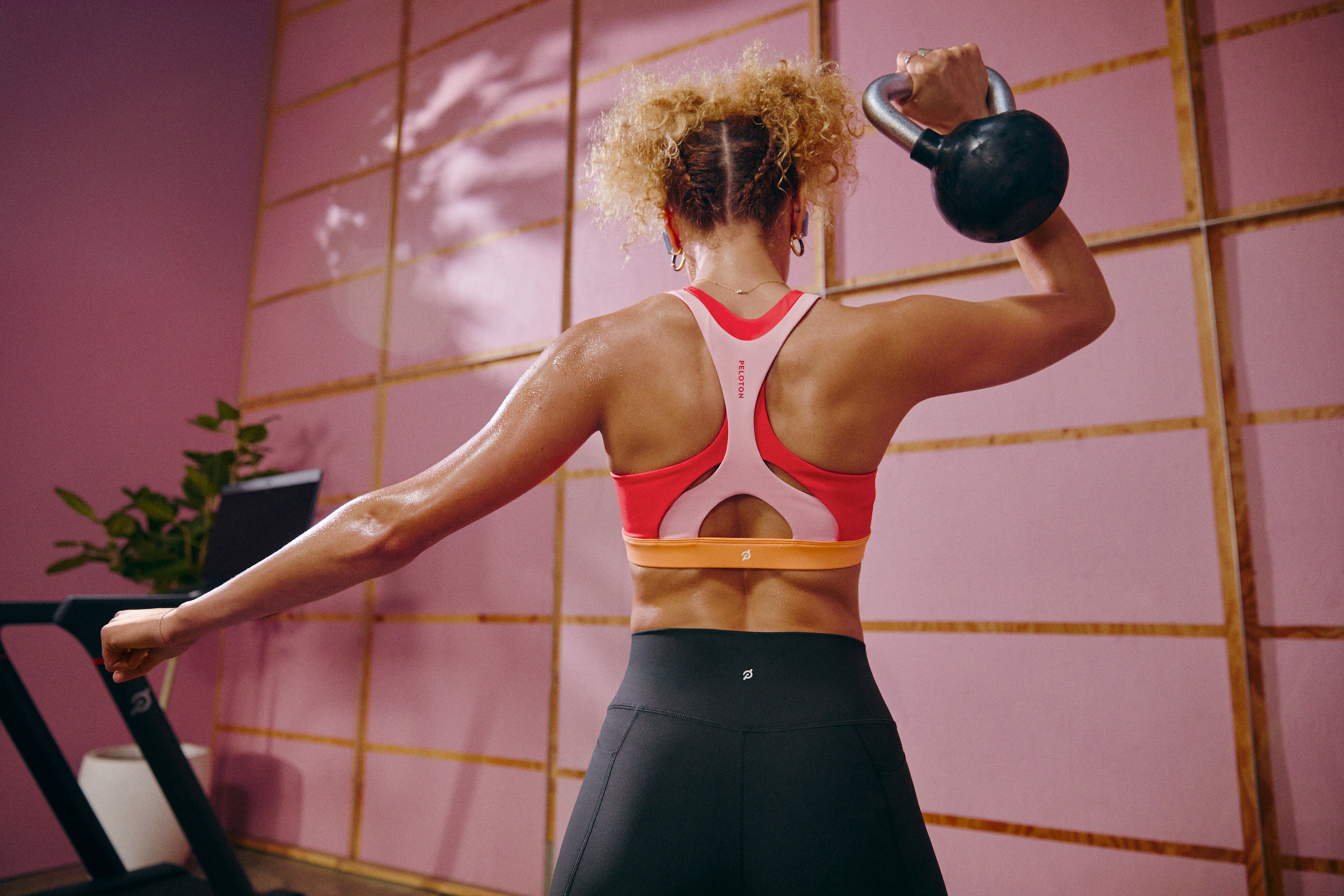
How to Start Strength Training
If you’re approaching strength training as a complete beginner, welcome! You’ll feel confident in your ability to target your workouts to your specific goals and needs sooner than you think. Just remember to give yourself ample time to warm up and cool down, and take things slow.
A tip from Cliff: Ask your gym about one-on-one coaching opportunities or classes available. “I would definitely recommend starting with a coach,” Cliff says. If that’s not an option, “beginner classes and sessions can help you learn the foundations of strength training, and learn how your body reacts to it.”
How Often Should You Strength Train?
Before starting with strength training, be sure you’re given the green light by a doctor, Matty advises. Once you’re set to go, Cliff suggests planning on two full-body strength training sessions per week, or “two workouts to train the legs and glutes, back, core, chest, shoulders, and arms,” he advises.
As you start to feel more comfortable, Cliff says you can up your sessions to three per week: one full-body session, one upper-body workout, and one lower-body day. You can also consider joining Peloton’s Beginner Strength Program and browsing through beginner strength training classes on the Peloton App.
More strength training isn’t necessarily better; you want to make sure you build in time for your muscles to rest and recuperate. This downtime is important because strength training causes tiny tears in the muscle tissue, which your body repairs and rebuilds bigger and stronger to better handle the workouts you’re putting it through. That’s essentially the process of building muscle. To make sure your body has enough time to do this important work, you should always give the targeted muscle groups at least 48 hours to recover in between training sessions.
What Equipment Do You Need to Strength Train?
The type of equipment you need as a strength training newbie really depends on your goal. “If your goal is significant strength gain and muscle growth, I’d always recommend training at a gym,” Cliff advises. “You have access to a wide range of equipment and can do the same exercises with different stimuli. These variations are important to include in a training program to give the muscle different types of stress and to keep progressing.”
Conversely, if you just want to feel stronger in everyday life, Cliff says that “you can already do a lot” with a set of dumbbells, resistance bands, or just your own body weight. “For example, a full-body workout with dumbbells and bands at home can be really effective, especially for beginners. Over time, you can still progress with tempo, reps, and increasing the weights.”
“I personally do a combination of at-home workouts with dumbbells and workouts in the gym… that’s also a good way of starting out,” Cliff adds.
How Do You Work All Your Muscle Groups?
If you’re brand new to resistance training, it’s easiest to let a fitness professional do the work for you, Cliff says. Either work with a coach in person or rely on beginner-friendly workout programs or classes, such as those on the Peloton App, to help you make sure you’re training all your muscle groups.
Once you get to the point where you can develop your own strength routine, you should aim to do at least two sessions per week of training all the main muscle groups in your body: legs, back, core, chest, shoulders, and arms. To do this, you can continue doing full body workouts every time you have a strength session scheduled, or try a workout split (where you divide up your training by muscle groups).
How Much Weight Should You Start with?
The first step for beginners should be bodyweight-only work, Matty says. “Do not jump right into weights before you spend at least two weeks moving through a bodyweight strength and balance routine,” he warns. Then, you can integrate light weights. (Although, reminder: You absolutely do not need to use weights to strength train. Bodyweight work is incredibly effective and a perfect first step.)
How much weight you use, if any, will largely depend on the exercise you’re doing and your experience/comfort level. If you’re starting from square one, choose a relatively light weight you can hold comfortably while standing, and attempt 12 to 15 repetitions. If the weight feels too heavy, reduce it. In the event it’s too light, you can up the weight. The goal? You should feel fatigued, but still be able to execute the final few reps with good form.
As long as you work the muscle to the point where you feel challenged, you’re doing the work necessary to make the muscle stronger. If an exercise is feeling easy and you don’t have heavier weights to pick up, use a lighter weight (or your body weight) but increase the challenge by doing a higher number of repetitions.
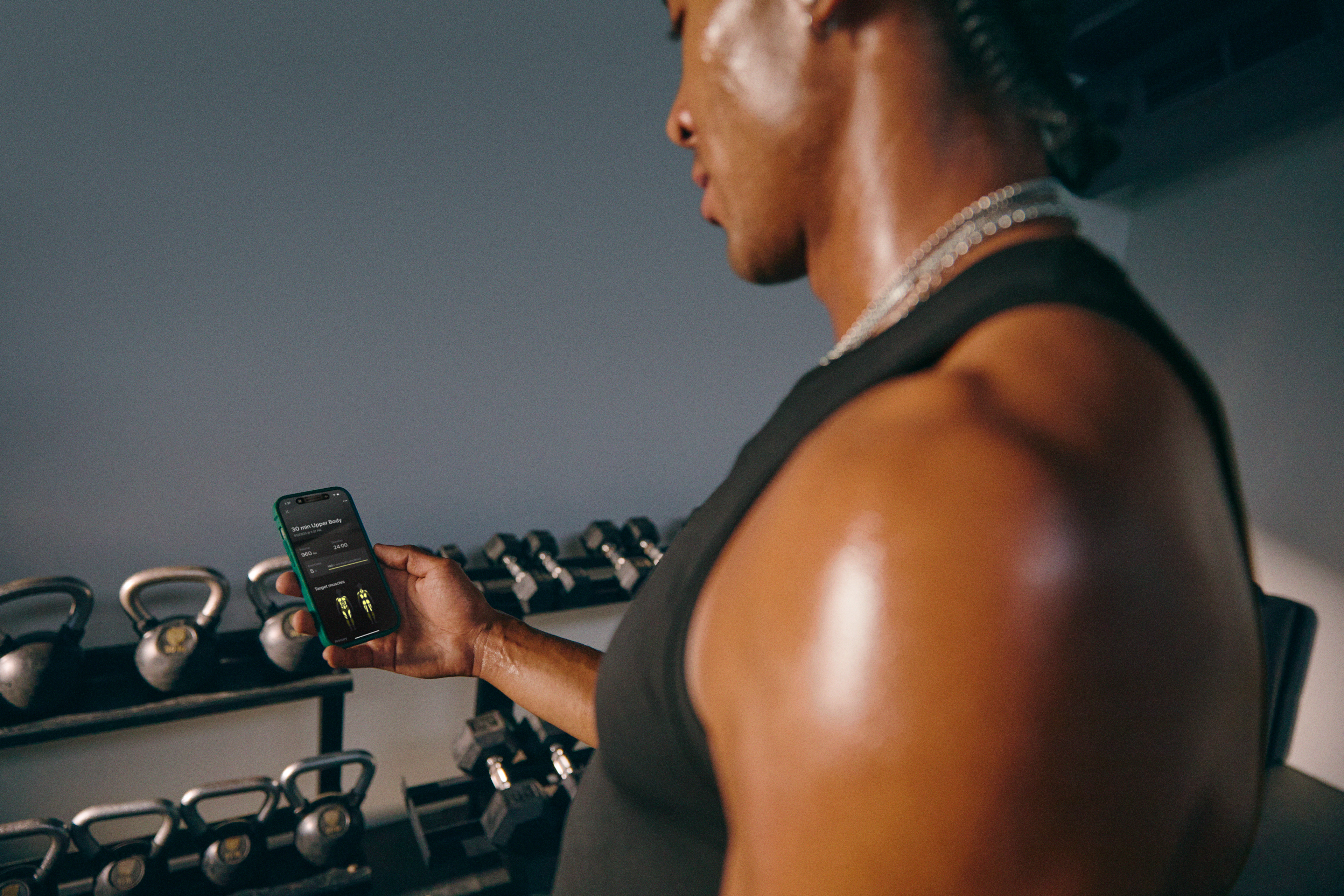
How and When Should You Increase Your Weights?
Of course, picking up and executing a few reps of a certain exercise is only the start. To reap the biggest benefits of a strength training routine, you need to challenge yourself consistently over time, says Cliff. “Just like planning a big project at work or analyzing if a marketing strategy works or not, we should plan and track our training to see if we’re heading in the right direction,” he explains. “With progressive overload, you track your training and aim to gradually increase your training volume (like weight, reps, or sets) over time, often without changing the overall structure of your program.”
Here are some general guidelines that can help determine whether you’re lifting the right weight:
You should start to feel the first rep.
The last few reps should challenge you without compromising your form.
If you breeze through the last few reps, you can likely increase the weight—or keep going for more reps.
“The idea is to gradually increase reps and or weight over time,” Cliff says. “You don’t need to change the whole program, just make small adjustments.”
How Quickly Will You See Results from Strength Training?
How quickly you’ll see tangible results from a strength training routine will vary based on a lot of factors, including your genetics, how often you train, and how intensely. But even a moderate amount of resistance exercise can be beneficial. A study from Medicine & Science in Sport & Exercise found that performing a series of nine strength exercises for 30 minutes twice per week led to increases in muscle size, strength, and endurance after just eight weeks. In general, experts estimate that it takes anywhere from four to 12 weeks to build muscle.
More good news: There is such a thing as “newbie gains,” which is when a newcomer to strength training experiences relatively quick changes in muscle strength and growth in the first few weeks after beginning to train. This is mainly a result of adaptations happening in your nervous system, as your body becomes better at recruiting and firing the right muscle fibers. This means you might be able to pick up heavier weights after just a few training sessions, or see a noticeable difference in how big your muscles look—just keep in mind, this kind of progress won’t last forever.
Sample Strength Training Exercises
So, where do you begin if you want to start your strength training routine? Matty is a huge fan of compound exercises (moves that engage multiple joints and muscle groups) as well as the 10-minute core classes on the Peloton App. Here are a few effective bodyweight strength training exercises that are perfect for beginners and will give you a preview of what to expect in a strength workout.
Just know that this is barely scratching the surface—there are countless strength training exercises out there, including plenty more lower body strength moves, upper body strength moves, and plenty of bodyweight exercises to try.
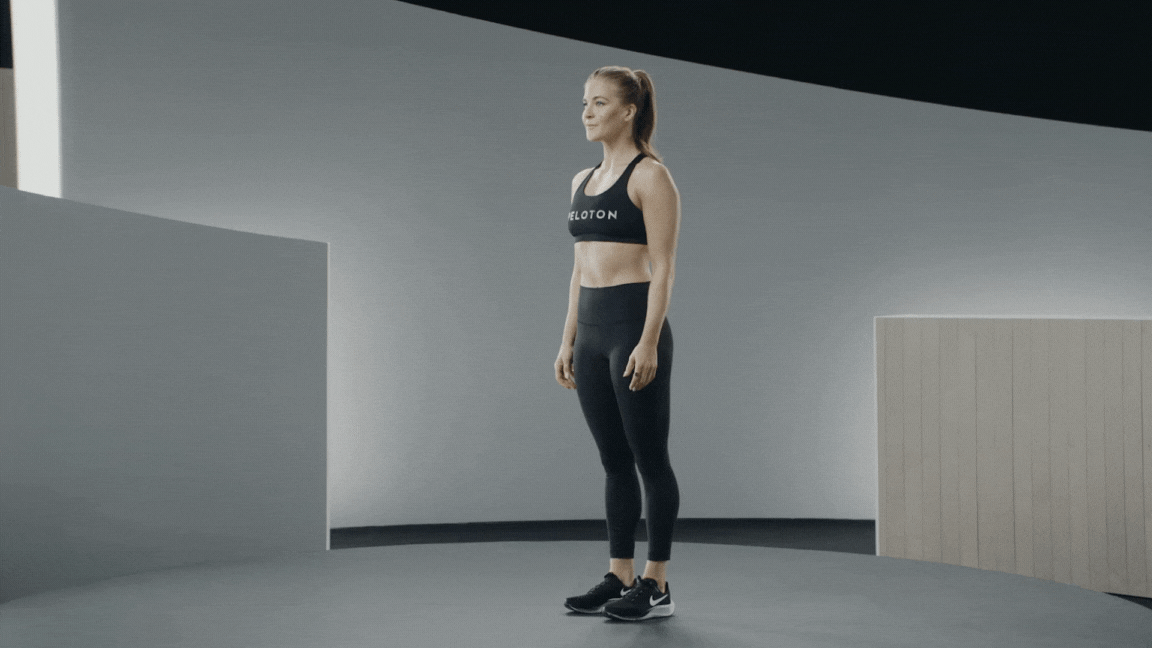
1. Squat
Squats are a workhorse of a move, but it’s important to make sure you’re doing them the right way. This lower body staple works your quads, glutes, hamstrings, and core.
Using either your own bodyweight or a medium dumbbell, start standing with your feet shoulder-width distance apart and your toes pointing forward. Clasp your hands together or hold the weight at chest level.
Slowly bend your knees and push your hips back, keeping your chest up while you squat down as if you were about to sit in a chair. Keeping your core engaged, back straight, and weight centered in your in your feet.
Push into the floor to straighten your knees and return to standing. Do 10–15 reps.

2. Reverse Lunge
This is a great unilateral exercise (i.e., performed on one side at a time) to help even out the strength in each leg and strengthen your core so that you can maintain your balance. You can use your body weight or hold a medium dumbbell in each hand by your sides.
Start standing with your feet hip-width distance apart.
Take a big step back onto the ball of your left foot, keeping the heel off the ground. Slowly bend both knees to 90 degrees, keeping your your core engaged.
Shift your weight into your right foot and push off the floor with your left foot, stepping it forward, next to the right foot, to return to standing.
Repeat on the opposite side. That’s one rep. Do 10–12 reps.
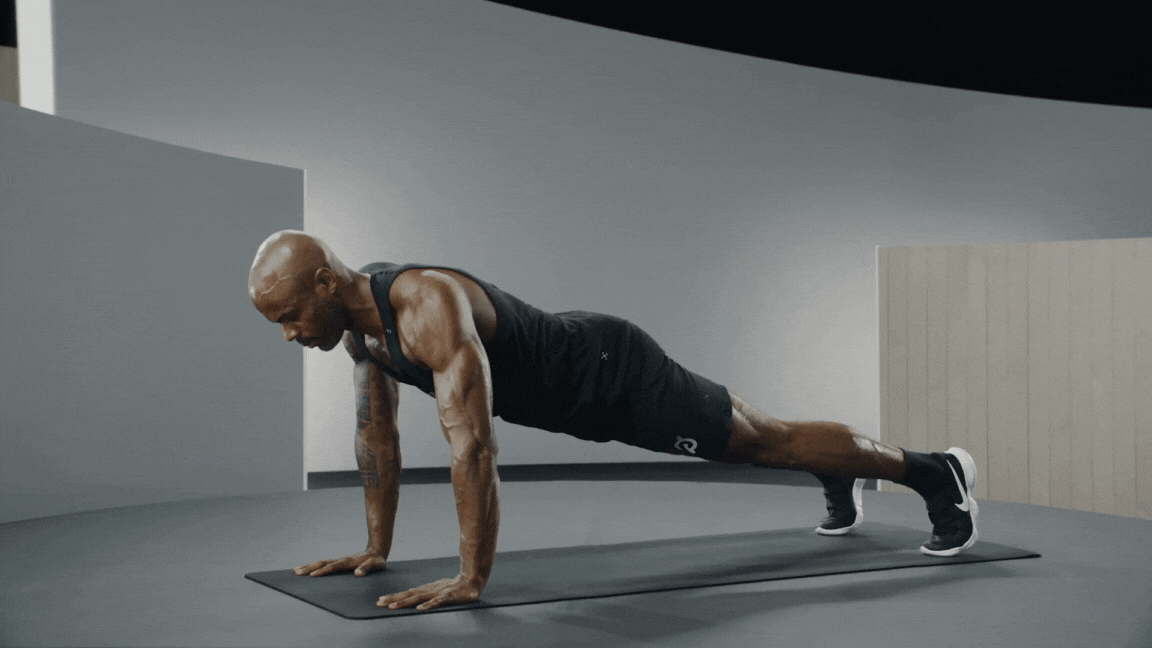
3. Push-Up
This exercise will help build strength and stability in your core while also working your chest, shoulders, and triceps. You can modify the exercise by doing it against a wall, or by lowering your knees to the floor.
Start on your hands and knees, with your palms directly under your shoulders.
Step your feet back and lift your knees off the floor so your legs are extended directly behind you.
Keeping your core engaged and your eyes on the floor, slowly lower down by bending your arms at the elbows until you are hovering over the floor. Then push back up to straighten your arms. Repeat 15 times.
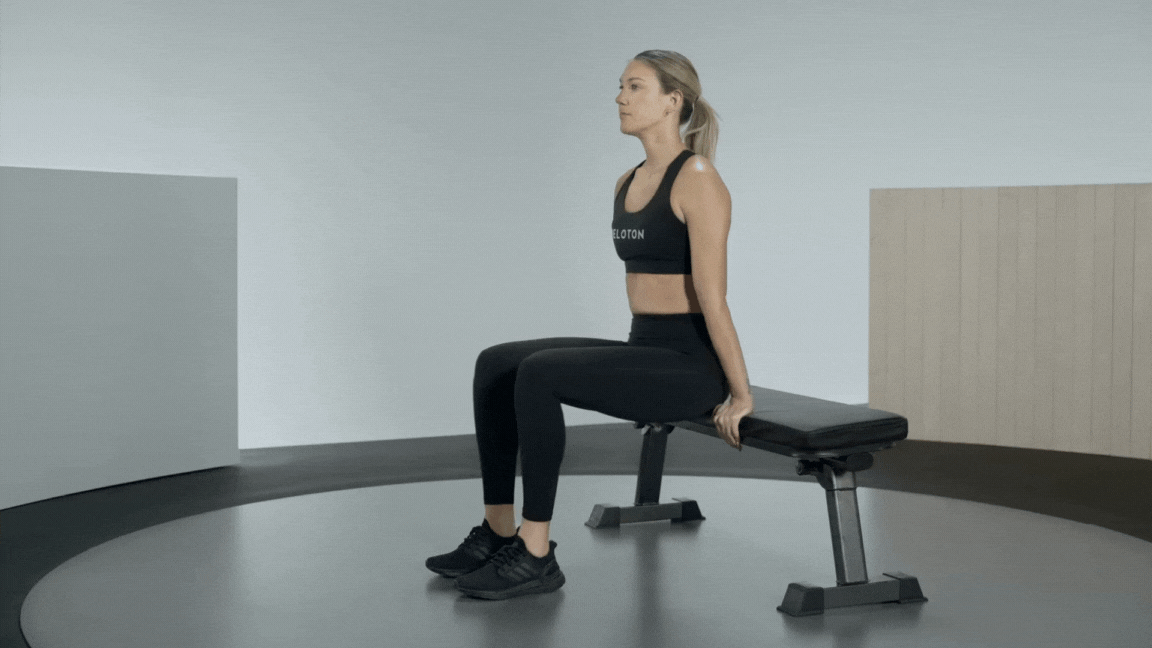
4. Triceps Dip
This is a tried-and-true bodyweight move excellent for building arm and shoulder strength, namely targeting your triceps (the muscles on the backs of your upper arms). You’ll need a stable step, bench, or chair, but you can also do triceps dips on the floor.
Sit on the edge of a bench with your hands on the bench on either side of your hips, fingers pointing forward. Extend your legs out in front of you, with a slight bend in your knees and your heels on the ground.
Press into your palms to lift your hips off the bench and shift your body slightly forward, so your hips clear the edge.
Keeping your back close to the bench, slowly bend your arms to lower your body until your elbows are bent at a 90-degree angle. Make sure your elbows are bending straight backward, not out to the sides.
Push through your palms to straighten your arms and return to the starting position. That's one rep. Do 10–15 reps.
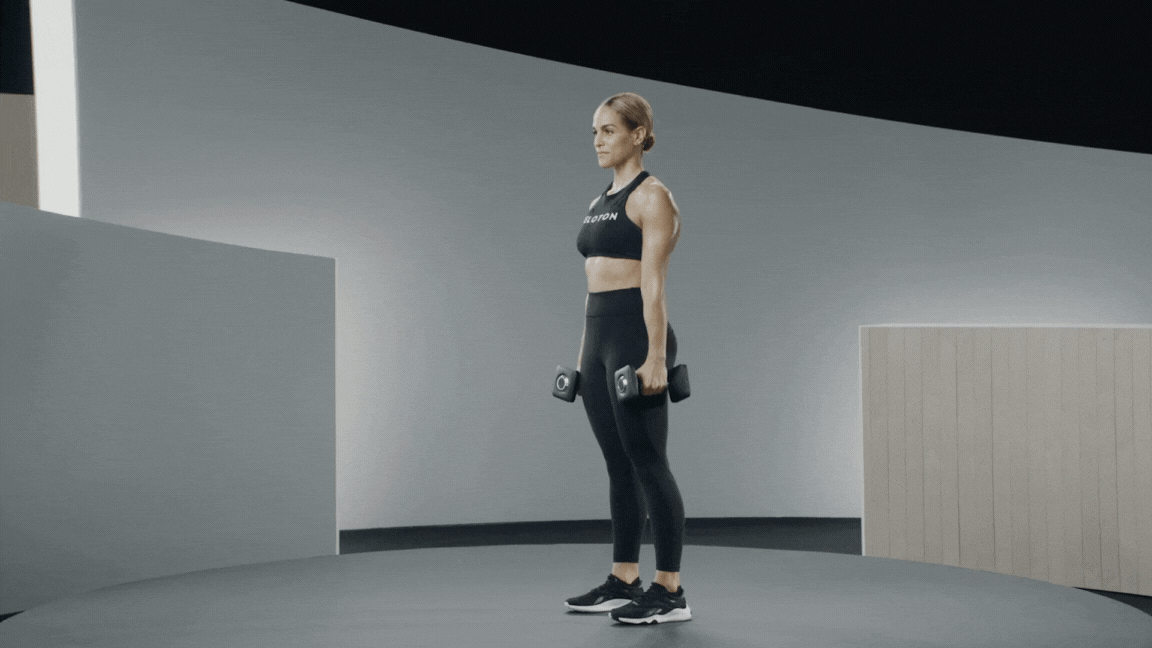
5. Dumbbell Bent-Over Row
This is a classic dumbbell back exercise great for improving your posture and grip strength. It targets the upper and middle back, biceps, shoulders, and core.
Start standing with your feet shoulder-width apart, holding a dumbbell in each hand with your palms facing each other. Keeping your back straight and knees slightly bent, hinge at your hips to lower your torso until it’s almost parallel to the floor. Let the dumbbells hang directly below your shoulders with your arms fully extended.
Engage your core and squeeze your shoulder blades together as you row the dumbbells up toward your ribs, keeping your elbows tucked in close to your body.
Pause at the top, then slowly lower the dumbbells back to the starting position with control. That’s one rep. Do 10–12 reps.
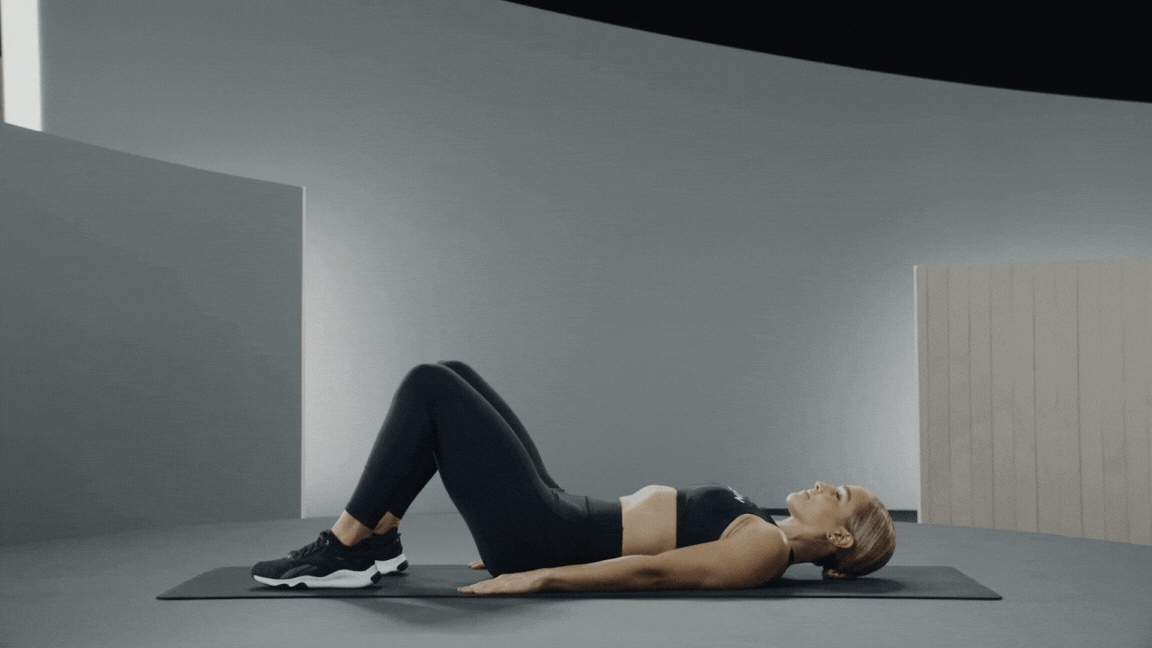
6. Glute Bridge
The glute bridge (sometimes called a hip bridge) is a deceptively simple exercise that’s highly effective for activating and strengthening your glutes, hamstrings, and core. You can perform this move with just your bodyweight or increase the challenge by placing a dumbbell horizontally on your hips.
Lie on your back with your knees bent, feet flat on the floor about hip-width apart, and your arms resting by your sides with your palms down.
Tuck your tailbone slightly and engage your core, then squeeze your glutes to lift your hips off the floor until your body forms a straight line from your shoulders to your knees.
Hold for a moment at the top, then slowly lower your hips to the floor with control.
Do 10–15 reps.
Try a Beginner Strength Class on the Peloton App
Tips to Keep in Mind When Strength Training
1. Focus on Form
When it comes to executing moves effectively and safely, again, Cliff says that relying on the help of a fitness pro is a good bet. That said, there are a few other overarching form tips to keep in mind during many strength exercises:
Maintain a hip-width stance and keep your feet firmly planted on the floor. Cliff notes that this applies to most lower body movements, like squats, deadlifts, and lunges.
Tilt your pelvis. In most strength exercises, you want to tilt your pelvis slightly to help activate your core, Cliff says. This also prevents your lower back from arching, which can sometimes lead to injuries.
Slow things down. Cliff says this is super important for the effectiveness of any exercise you do (the more time your muscles are under tension, the better!), but also for safety. Rushing through a move can make you more likely to injure yourself.
Don’t try to lift too heavy. Matty says that too many people end up grabbing the wrong weight and repping it out as fast as possible with terrible form, which can lead to injury. “Be a tortoise, not a hare,” he encourages.
2. Warm Up Well
Don’t sleep on your warm-up: Studies show that warming up prior to strength training can help boost muscle force production (aka help increase your total output and reduce fatigue). A dynamic warm-up, which includes exaggerated, load-free variations of the moves you’ll do in your strength training session, can also help prevent injuries, research shows. If your workout or class doesn’t include a warm-up, try cueing up a 5- or 10-minute Strength Warm Up class on the Peloton App before you get started.
3. Engage Your Core and Don’t Forget to Breathe
As Cliff points out, all strength training exercises stem from the core, which makes keeping it engaged throughout the movement paramount. “The combination of engaging your core and breathing is essential when it comes to strength training,” he explains. Typically, you’ll breathe in during the eccentric (lengthening or lowering) portion of a lift and breathe out during the concentric phase (or where your muscle contracts). For example, in a squat, you’d breathe in during the lowering (eccentric) phase, and breathe out on the way up (the concentric phase). “While breathing out, you’re trying to ‘squeeze’ your abs,” Cliff says.
Get Started Strength Training with Peloton
Ready to get stronger? You only stand to gain physically and mentally once you start on a strength training path. Remember, when it comes to results, repetition and consistency are key to growing stronger. Strength training is an acquired skill, and it may take some trial and error to figure out the best tools, weight, and exercises for your body and goals. But the longer you commit to it, the more you’ll realize that a well-rounded strength training routine is worth the effort.
No matter your fitness level or goals, Peloton can help you lock into a winning strength training plan. Check out the Peloton App for a variety of on-demand classes, a community of motivating instructors, and pre-made and personalized strength training plans for all levels that take care of organizing your routine for you. If you’re headed to the gym, consider trying Peloton Strength+, which offers custom and instructor-led workout programs you can tailor to whatever equipment your gym has on hand.
This content is for informational and educational purposes only and does not constitute individualized advice. It is not intended to replace professional medical evaluation, diagnosis, or treatment. Seek the advice of your physician for questions you may have regarding your health or a medical condition. If you are having a medical emergency, call your physician or 911 immediately.
Level up your inbox.
Subscribe for a weekly dose of fitness, plus the latest promos, launches, and events.
By providing your email address, you agree to receive marketing communications from Peloton.
For more about how we use your information, see our Privacy Policy.

